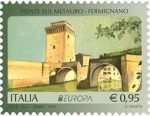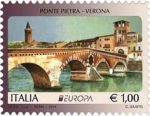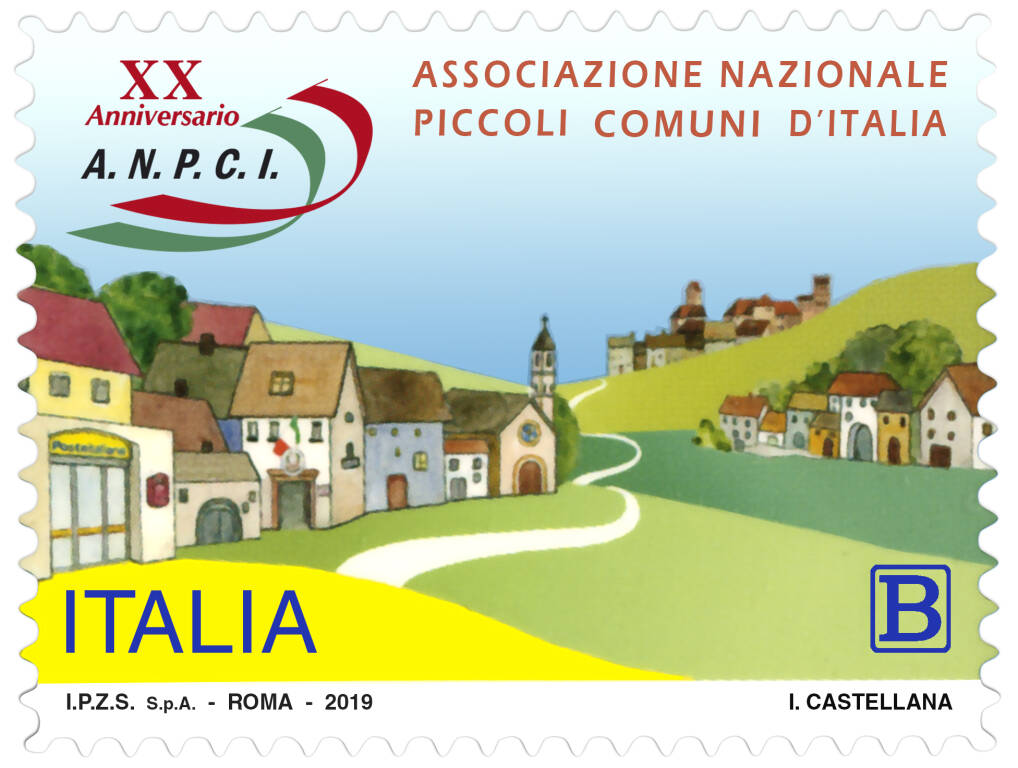POSTE ITALIANE 7^ Emissione del 09 maggio 2018
Titolo: EUROPA Ponte sul Metauro – Fermignano
| data /date | 09.05.2018 |
| n. catalogo / n. catalog | Michel 4038 – YT 3799 – Un. 3881 – Sn. 3505 |
| dentellatura/Serration | 11 |
| stampa/printing | fustellatura – rotocalco |
| tipo di carta/paper type | bianca patinata neutra |
| stampato | I.P.Z.S. Roma |
| fogli/sheet | 45 |
| dimensioni/dimensions | 40 x 30mm |
| disegnatore /designer | C. Giusto |
| tiratura | 600.000 |
Il ponte romano di Fermignano è un ponte in pietra a tre arcate che attraversa il fiume Metauro all’interno dell’abitato di Fermignano, in provincia di Pesaro e Urbino. Il ponte si trova al centro del paese di Fermignano, in un punto dove il fiume Metauro genera una piccola cascata. La struttura, composta da tre grandi arcate, è stata realizzate in blocchetti di pietra disposti in filari, intervallati da tratti in mattoni inseriti durante successivi restauri.
Circa a metà del ponte si trova una piccola edicola votiva eretta per volere di Federico da Montefeltro intorno alla metà del XV secolo e realizzata forse sotto la direzione dell’architetto senese Francesco di Giorgio Martini. Al suo interno è conservato un affresco di fattura tardo-quattrocentesca (o cinquecentesca secondo altri studiosi) raffigurante una Madonna col Bambino soprannominata “Madonna del Ponte”. La prima menzione del ponte risale al 1364, ma la tradizione locale fa risalire la sua costruzione all’epoca romana. Mentre la tecnica costruttiva, con blocchetti di pietra intervallati da tratti in mattoni, è analoga a quella dell’adiacente torre medievale, la tipologia dei piloni del ponte e dei suoi cunei frangi corrente ricorda quella di alcuni ponti romani presenti lungo la Via Flaminia. Alcune fonti storiche inoltre confermerebbero che nel sesto secolo d.C., durante la guerra tra Goti e Bizantini, esisteva un attraversamento del fiume Metauro proprio nella zona dove ora si trova il paese di Fermignano.
Accanto al ponte si trova una torre medievale conosciuta come “torre delle milizie”, citata per la prima volta in un documento del 1418, quando un consiglio cittadino si riunì al suo interno, e divenuta il simbolo di Fermignano, che costituiva con il ponte un unico complesso monumentale di controllo dei transiti e difesa della cittadina. È possibile che la torre sia stata costruita nel medioevo sulle fondamenta di una precedente struttura di epoca romana.
A fianco alla torre intorno al 1407 fu realizzata una cartiera, alimentata dall’acqua del fiume Metauro. Inizialmente di proprietà dei duchi di Urbino, nel 1507 fu donata da Guidobaldo da Montefeltro alla Cappella Musicale del SS. Sacramento di Urbino, che ne restò in possesso fino al 1870, e nel 1703 era considerata una delle maggiori dello Stato della Chiesa. Intorno al 1915 fu trasformata in lanificio.
Title: EUROPA Ponte sul Metauro – Fermignano
The Roman bridge of Fermignano is a stone bridge with three arches that crosses the Metauro river inside the town of Fermignano, in the province of Pesaro and Urbino. The bridge is located in the center of the village of Fermignano, in a point where the Metauro river generates a small waterfall. The structure, composed of three large arches, was made of stone blocks arranged in rows, interspersed with brick sections inserted during subsequent restorations.
About halfway across the bridge is a small votive shrine erected by Federico da Montefeltro around the middle of the fifteenth century and built perhaps under the direction of the Sienese architect Francesco di Giorgio Martini. Inside there is a fresco of late fifteenth-century (or sixteenth century according to other scholars) depicting a Madonna with Child nicknamed “Madonna del Ponte”. The first mention of the bridge dates back to 1364, but the local tradition traces its construction back to Roman times. While the construction technique, with blocks of stone interspersed with sections of brick, is similar to that of the adjacent medieval tower, the type of pylons of the bridge and its wedges frangi current reminds that of some Roman bridges along the Via Flaminia. Some historical sources also confirm that in the sixth century AD, during the war between Goths and Byzantines, there was a crossing of the Metauro river in the area where the village of Fermignano is now located.
Next to the bridge is a medieval tower known as the “tower of the militia”, mentioned for the first time in a document dated 1418, when a city council met inside it, and became the symbol of Fermignano, which constituted with the bridge a unique monumental control of transits and defense of the town. It is possible that the tower was built in the Middle Ages on the foundations of a previous Roman structure.
Next to the tower around 1407 a paper mill was built, fed by the water of the Metauro river. Initially owned by the Dukes of Urbino, in 1507 it was donated by Guidobaldo da Montefeltro to the Cappella Musicale del SS. Sacramento of Urbino, which remained in possession until 1870, and in 1703 was considered one of the largest of the Papal States. Around 1915 it was transformed into a woolen mill.
| data /date | 09.05.2018 |
| n. catalogo / n. catalog | Michel 4039 – YT 3800 – Un. 3882 – Sn. 3506 |
| dentellatura/Serration | 11 |
| stampa/printing | fustellatura – rotocalco |
| tipo di carta/paper type | bianca patinata neutra |
| stampato | I.P.Z.S. Roma |
| fogli/sheet | 45 |
| dimensioni/dimensions | 40 x 30mm |
| disegnatore /designer | C. Giusto |
| tiratura | 600.000 |
Titolo: EUROPA Ponte Pietra – Verona
Il ponte, lungo 92,80 metri e largo 7,20 metri, marciapiedi e parapetti compresi, è costituito da cinque arcate. La spalla e le due arcate verso campagna risalgono all’epoca romana, la spalla destra con la soprastante torre, e l’arco adiacente, sono di epoca scaligera, mentre le due arcate rimanenti con il grande tondo centrale sono del periodo veneziano. La parte romana è costituita da grandi blocchi di pietra provenienti dal territorio di Sant’Ambrogio di Valpolicella, mentre la parte scaligera e veneta è costituita principalmente da cotto, anche se le ghiere degli archi ed il tondo sono irrobustiti da lastroni in pietra della stessa provenienza di quelli romani. Il ponte si colloca in un punto che fin dalla Preistoria doveva presentare un guado, punto d’incontro cruciale tra diverse vie di comunicazione a cui si deve la nascita della città di Verona. Un primo ponte in legno venne messo in opera durante la costruzione della via Postumia nel 148 a.C. nello stesso punto in cui era presente il guado, in quanto in quel luogo il fiume raggiunge una larghezza minima di 92 metri e la corrente arriva con una potenza ridotta a causa dell’ampio meandro che deve compiere. Questo è anche il motivo per cui il ponte non si trova orientato in asse con i decumani della città, la quale venne ricostruita all’interno dell’ansa dell’Adige solo dopo che divenne colonia latina, nell’ 89 a.C. Il ponte ligneo venne probabilmente sostituito con uno lapideo proprio in quello stesso periodo, divenendo uno dei massimi monumenti della Verona romana.
Nel 1298 Alberto della Scala fece restaurare la torre verso città, ancora oggi presente, mentre nel 1368 Cansignorio realizzò un acquedotto che passava sul ponte che diede acqua corrente a diverse abitazioni del centro storico e alla fontana di Madonna Verona, posta al centro di piazza Erbe. Nello stesso periodo il ponte, che ospitava numerose abitazioni in legno di barcaioli e molinari, oltre che botteghe e osterie, venne munito di una seconda torre che serrava il ponte verso campagna.
Nel 1503 venne ristrutturato per essere realizzato completamente in pietra, ma prima della fine dei lavori crollò parzialmente e venne quindi sostituito da una struttura lignea. Nel 1508, però, il Consiglio della città chiese a Fra’ Giocondo di sovrintendere ai lavori di ricostruzione del ponte romano, fabbrica che divenne operativa solo nel 1520 con la costruzione dei tre archi verso città, che il Giocondo provvide di rendere armonici rispetto ai due archi romani superstiti verso campagna. I lavori si conclusero nel 1521, sempre sotto la direzione del frate/architetto.
Il Ponte di Pietra ha avuto una vita molto travagliata:
- già in età imperiale, sul finire del II secolo, il ponte venne ristrutturato su modello dell’originario a causa di un crollo parziale, o forse perfino totale;
- nel 1007 un’inondazione del fiume provocò un nuovo crollo del ponte, quindi ricostruito;
- un altro crollo avvenne nel 1153, ma sicuramente più rovinoso fu quello del 1232, conseguente all’assedio della città, che portò alla distruzione delle arcate verso città, poi sostituite temporaneamente da una struttura lignea e, nel 1234, da arcate in cotto;
- un altro crollo parziale, sempre dovuto ad una piena dell’Adige, si ebbe probabilmente il 3 ottobre 1239;
Dopo alcuni secoli di relativa tranquillità, nel 1801 venne demolita la torre che sorgeva verso campagna, e nel giro di pochi anni vennero pure eliminate le numerose casupole sorte lungo tutto lo sviluppo del ponte, in quanto considerate non compatibili dall’amministrazione con la maestosità del monumento romano. Gravissimo danno ebbe però il 25 aprile 1945, quando il ponte venne minato e fatto saltare dai tedeschi in ritirata, esplosione che lasciò integro solamente l’arcata verso città.
Title: EUROPA Ponte Pietra – Verona
The bridge, 92.80 meters long and 7.20 meters wide, including sidewalks and parapets, consists of five arches. The shoulder and the two arches towards the countryside date back to Roman times, the right shoulder with the tower above, and the adjacent arch, are from the Scaliger era, while the two remaining arches with the large central round are from the Venetian period. The Roman part is made up of large blocks of stone from the territory of Sant’Ambrogio di Valpolicella, while the Scaligeri and Veneto are mainly made of terracotta, although the arched arches and the round are strengthened by stone slabs of the same origin of the Roman ones. The bridge is located in a point that since prehistoric times had to present a ford, a crucial meeting point between different ways of communication to which we owe the birth of the city of Verona. A first wooden bridge was put in place during the construction of the Postumia street in 148 BC. in the same spot where the ford was present, because in that place the river reaches a minimum width of 92 meters and the current arrives with a reduced power due to the wide meander it has to do. This is also the reason why the bridge is not oriented in line with the decumani of the city, which was rebuilt within the bend of the Adige only after it became a Latin colony, in 89 BC. The wooden bridge was probably replaced with a stone in that same period, becoming one of the greatest monuments of Roman Verona.
In 1298 Alberto della Scala had the tower restored to the city, still present today, while in 1368 Cansignorio built an aqueduct that passed on the bridge that gave running water to several houses in the historic center and the fountain of Madonna Verona, located in the center of Piazza Erbe . In the same period, the bridge, which housed many wooden houses of boatmen and millers, as well as shops and taverns, was equipped with a second tower that held the bridge towards the countryside.
In 1503 it was renovated to be completely made of stone, but before the end of the work it collapsed partially and was then replaced by a wooden structure. In 1508, however, the city council asked Fra ‘Giocondo to oversee the reconstruction of the Roman bridge, a factory that became operational only in 1520 with the construction of the three arches towards the city, which Giocondo provided to make harmonious with respect to the two Roman arches surviving towards the countryside. The work was completed in 1521, again under the direction of the friar / architect.
The Stone Bridge has had a very troubled life:
already in the imperial age, at the end of the II century, the bridge was restructured on the original model because of a partial collapse, or perhaps even total;
in 1007 a flood of the river caused a new collapse of the bridge, then rebuilt;
another collapse occurred in 1153, but certainly more ruinous was that of 1232, consequent to the siege of the city, which led to the destruction of the arcades to cities, then temporarily replaced by a wooden structure and, in 1234, by brick arches;
another partial collapse, again due to a flood of the Adige, probably occurred on 3 October 1239;
After a few centuries of relative tranquility, in 1801 the tower that was built towards the countryside was demolished, and within a few years the numerous houses built along the entire length of the bridge were eliminated, as they were considered incompatible by the administration with the majesty of the Roman monument. However, on 25 April 1945, extremely serious damage occurred when the bridge was mined and blown up by the retreating Germans, an explosion that left only the archway intact towards the city.








